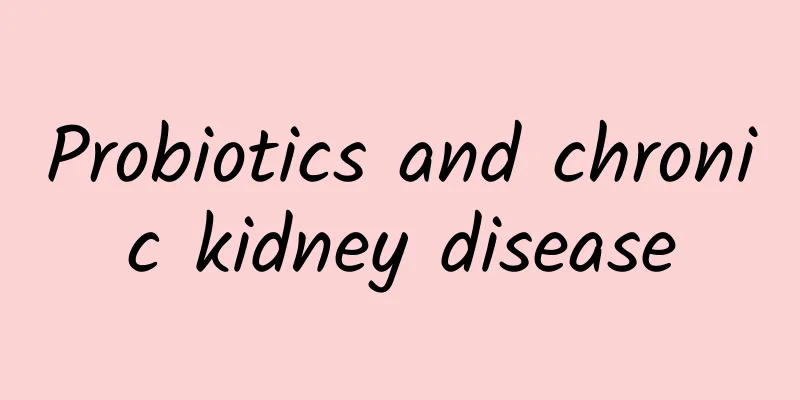Probiotics and chronic kidney disease

|
Among children, there is a special group. They can only eat limited food every day, go to the hospital three times a week, have tubes inserted into their bodies, do dialysis for a morning, and then go home. Most of them are thin, easy to catch colds, and live cautiously. Xiao Xiongmao is such a child. He is 16 years old, diagnosed with chronic kidney disease for 9 years, and has been on dialysis for 8 years. Recently, he didn't want to eat. After his mother gave him some probiotics, his appetite improved a lot. I saw on the Internet that probiotics can be taken for a long time, can regulate gastrointestinal flora, and can also slow down the progression of the disease by hindering the production of intestinal toxins. Chronic kidney disease is a clinical syndrome characterized by disordered kidney structure and long-term abnormal kidney function. The late stage of chronic kidney disease is also called uremia, and life is maintained by dialysis. According to foreign reports, if a suitable kidney source cannot be found, the remaining life expectancy of children receiving dialysis is 22-24 years. The ability to remove toxins by dialysis is limited, so the red panda mother is willing to try any drug that can hinder the production of intestinal toxins. Today, let's take a look at the role of probiotics in chronic kidney disease. 1. Children with chronic kidney disease and intestinal flora imbalance First, renal dysfunction in children with chronic kidney disease can lead to the accumulation of metabolic waste, causing intestinal mucosal ischemia, damaged mucosal barriers, and increased permeability. And due to the presence of chronic inflammation, the growth environment of the flora has changed. Secondly, the nutritional status of children with chronic kidney disease is generally poor, and there is a lack of nutritional substrates for the intestinal flora that are beneficial to the body, thereby inhibiting the growth of the dominant flora. Thirdly, due to the inhibition of the growth of the dominant flora, intestinal peristalsis slows down and sluggishness, and the intestinal clearance capacity is reduced, providing pathogenic bacteria with the opportunity to contact and adhere to the mucosa. 2. Probiotics and toxin removal Hemodialysis can only remove free microorganisms, resulting in very limited removal. Prolonging dialysis time will make children intolerant, so to reduce toxins in the body, it can also be done by reducing production. In one study, it was suggested that preparations containing Bacillus pasteurianus and Lactobacillus acidophilus could reduce blood urea nitrogen and serum creatinine levels. Similar studies have shown that lactic acid bacteria can reduce the levels of enterogenic uremic toxins indoxyl sulfate and p-cresol in the blood and inhibit systemic micro-inflammatory responses. Bifidobacteria can effectively reduce serum TNF-α and IL-6 levels, reduce C-reactive protein levels in maintenance hemodialysis patients, and inhibit inflammatory responses. So, are all probiotics containing the above-mentioned bacteria recommended for use? Unfortunately, there is no such large-scale research at present, and individual studies are not enough to promote. 3. How to use probiotics? Although probiotics are beneficial for children with chronic kidney disease, the relevant guidelines do not routinely recommend the use of probiotics. They are only recommended when there is a clear imbalance in the intestinal flora. In order to make probiotics grow better in the intestines, it is recommended to take prebiotics, which are foods for probiotics, to promote the proliferation of probiotics. Studies have shown that the combination of the two can change the intestinal flora of patients with chronic kidney disease, reduce the production of uremic toxins, and thus slow down the occurrence of cardiovascular complications. Clostridium butyricum and Bifidobacterium, which are commonly used in children, have a bacterial population of 106-107 CFU due to different preparations. However, this order of magnitude of bacterial population is far from enough to remove uremic toxins. Foreign studies have shown that only when the bacterial population reaches 109 will there be a significant effect on toxins, and the greater the number, the better the removal effect. A bacterial population of 16×109 CUF can reduce serum urea levels more than 8×109 CUF. To sum up, probiotics are medicines, and all medicines are toxic. Without extensive safety and effectiveness evaluation, it is best not to give them to children for a long time. References 1.Vitetta L, Gobe G. Uremia and chronic kidney disease: The role of the gut microflora and therapies with pro- and prebiotics[J]. Molecular Nutrition & Food Research, 2013, 57(5):824-832. 2.Miranda Alatriste PV, Urbina AR, Gómez Espinosa CO, et al. Effect of probiotics on human blood urea levels in patients with chronic renal failure[J]. Nutricion Hospitalaria, 2014, 29(3):582-590. 3.Wang IK, Wu YY, Yang YF, et al. The effect of probiotics on serum levels of cytokine and endotoxin in peritoneal dialysis patients: A randomized, double-blind, placebo-controlled trial[J]. Beneficial Microbes, 2015, 6(4):1-8. 4.Taki K, Takayama F, Niwa T. Beneficial effects of Bifidobacteria in a gastroresistant seamless capsule on hyperhomocysteinemia in hemodialysis patients[J]. Journal of Renal Nutrition, 2005, 15(1):77-80. |
Recommend
There are a lot of spots on my face suddenly
Women all want to have smooth skin, without any f...
What can women eat to gain weight
Now many people are paying attention to how to lo...
Can I eat donkey-hide gelatin cake during early pregnancy?
We all know that donkey-hide gelatin cake has man...
What causes pain on both sides of the lower abdomen in women?
There are many causes of lower abdominal pain. If...
What is the best medicine for female tinnitus?
Ear problems have become more and more common in ...
How does a woman with exposed nostrils look like?
Women with exposed nostrils are very unsightly an...
What should I do if I suffer from breast fibroids?
Adenofibroma is a disease that affects women'...
How to determine breast hyperplasia? These methods can help you
For diseases such as breast hyperplasia, women mu...
Brief discussion: Why has cancer not been conquered yet?
Cancer is a major problem that modern medicine ca...
Table of prohibited ingredients in skin care products for breastfeeding period
When it comes to skin care during pregnancy, one ...
Generally speaking, bleeding starts on the first day of medical abortion
Medical abortion means that the pregnancy time mu...
Pregnant boy development early or late
There are many opinions among us about whether th...
What causes white discharge inside a woman's vagina?
Some women experience a white vagina, which may s...
Can I take cold medicine during menstruation?
Women should not eat random foods or take random ...









